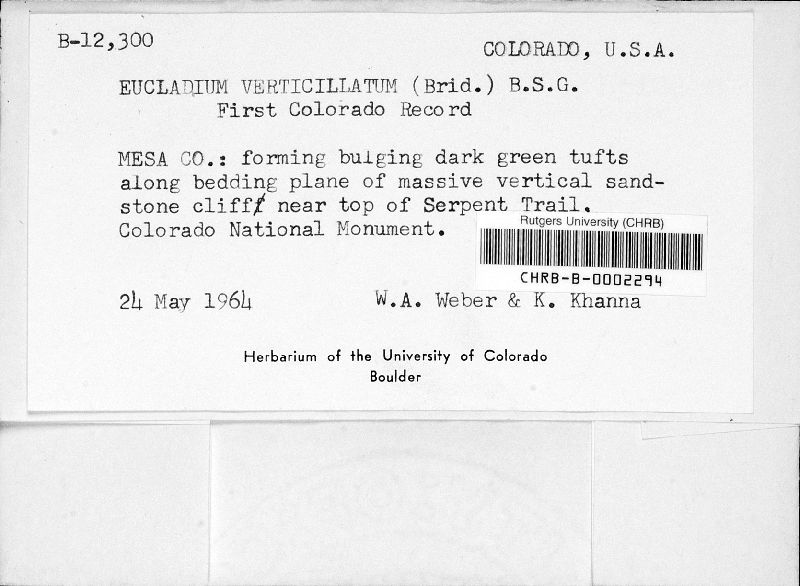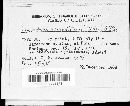

- Home
- Specimen Search
- Images
- Flora Projects
- Agency Floras
- Dynamic Floras
-
Additional Websites
- New Mexico Flores
- Plant Atlas Project of Arizona (PAPAZ)
- Southwest Colorado Wildflowers
- Vascular Plants of the Gila Wilderness
- Consortium of Midwest Herbaria
- Consortium of Southern Rocky Mountain Herbaria
- Intermountain Region Herbaria Network (IRHN)
- Mid-Atlantic Herbaria
- North American Network of Small Herbaria (NANSH)
- Northern Great Plains Herbaria
- Red de Herbarios del Noroeste de México (northern Mexico)
- SERNEC - Southeastern USA
- Texas Oklahoma Regional Consortium of Herbaria (TORCH)
- Resources
|
|
|
|
Family: Pottiaceae
[Weissia verticillata] |
Stems erect, 0.7-6 cm, leaves often branched in whorls in successive innovations. Leaves 1.2-2.5 mm, flat to channeled distally or at mid leaf, in transverse section at mid leaf often tapering from costa to leaf margin because of decreasing size of cells, mucro occasionally ending in a sharp, clear cell; marginal serrulations projecting from the distal end of cells of the hyaline cells of the leaf base; costa to 1/3 or more the width of the leaf near the base, basal cells 12-15 µm wide, 2-5:1; median and distal laminal cells 8-10 µm wide, 1(-2):1, walls rather thick, often irregularly so, large juxtacostally and decreasing in size to the leaf margin, irregular in shape from quadrate to rectangular, 1-2(-3):1, sometimes transversely elongate 2:1, occasionally with transverse walls oblique, marginal cells narrower in places and 2-3:1 occasionally approximating a border; papillae variously scattered or centered. Seta yellow to red‑brown, not or little twisted. Capsule 0.8-1.8 mm, red-brown when old; operculum 0.5-0.8 mm; peristome rudimentary or to 300 µm, yellow to orange, with a low, papillose basal membrane. Calyptra ca. 2.5 mm. Spores pale. Sporophytes infrequent, capsules mature Jun-Aug. Dripping calcareous or sometimes granitic rock faces or mortar, around springs, dripping bluffs in calcareous regions; low to high elevations (0-1900 m); Alta., B.C., Nfld. and Labr. (Nfld.), Ont.; Ala., Ariz., Ark., Calif., Colo., Fla., Idaho, Ill., Ind., Kans., Ky., Mich., Miss., Mo., Nev., N.Mex., Ohio, Okla., Tenn., Tex., Utah, Va., Wash., Wis.; Mexico; Bermuda; Central America; Europe; Asia; n, s Africa; Atlantic Islands (Macaronesia). Eucladium verticillatum is associated with year‑round seepage, possibly the reason that, although the stem may be reduced, the leaves are seldom reduced as they frequently are in drought-tolerant species of the family. The plants are typically a yellow-green, and there is usually a vivid contrast between the pellucid green laminal cells and the clear basal ones. Stem hyalodermis cells are frequently attached to the costa base, and form decurrencies of long and thin-walled cells in the leaf angles when leaves are removed. Gymnostomum and Molendoa are similar plants but differ by blunt apices and subpercurrent costae. Both these genera possess a stem central strand, no hyalodermis, and occasional 2-stratose areas in the lamina. Eucladium may be separated from these taxa and others that may be mistaken for it, such as Hymenostylium and Anoectangium by its highly differentiated bulging or lax, thin-walled basal cells. Assurances in the literature to the contrary, many other taxa also possess serrulate or denticulate leaf-shoulder margins, especially Hymenostylium, while Eucladium may rarely lack such serrulations. Specimens of Eucladium in which the lamina is highly reduced so that the leaves seem entirely costate are included without special rank in the range of variation of the species in North America. The laminal papillae of Hymenostylium are clear, sharp, well-defined; those of Eucladium are low, amorphous or scablike on the lumen surface.
|

Development supported by National Science Foundation Grants
(DBI 9983132,
BRC 0237418,
DBI 0743827,
DBI 0847966)
Powered by Symbiota
Powered by Symbiota




